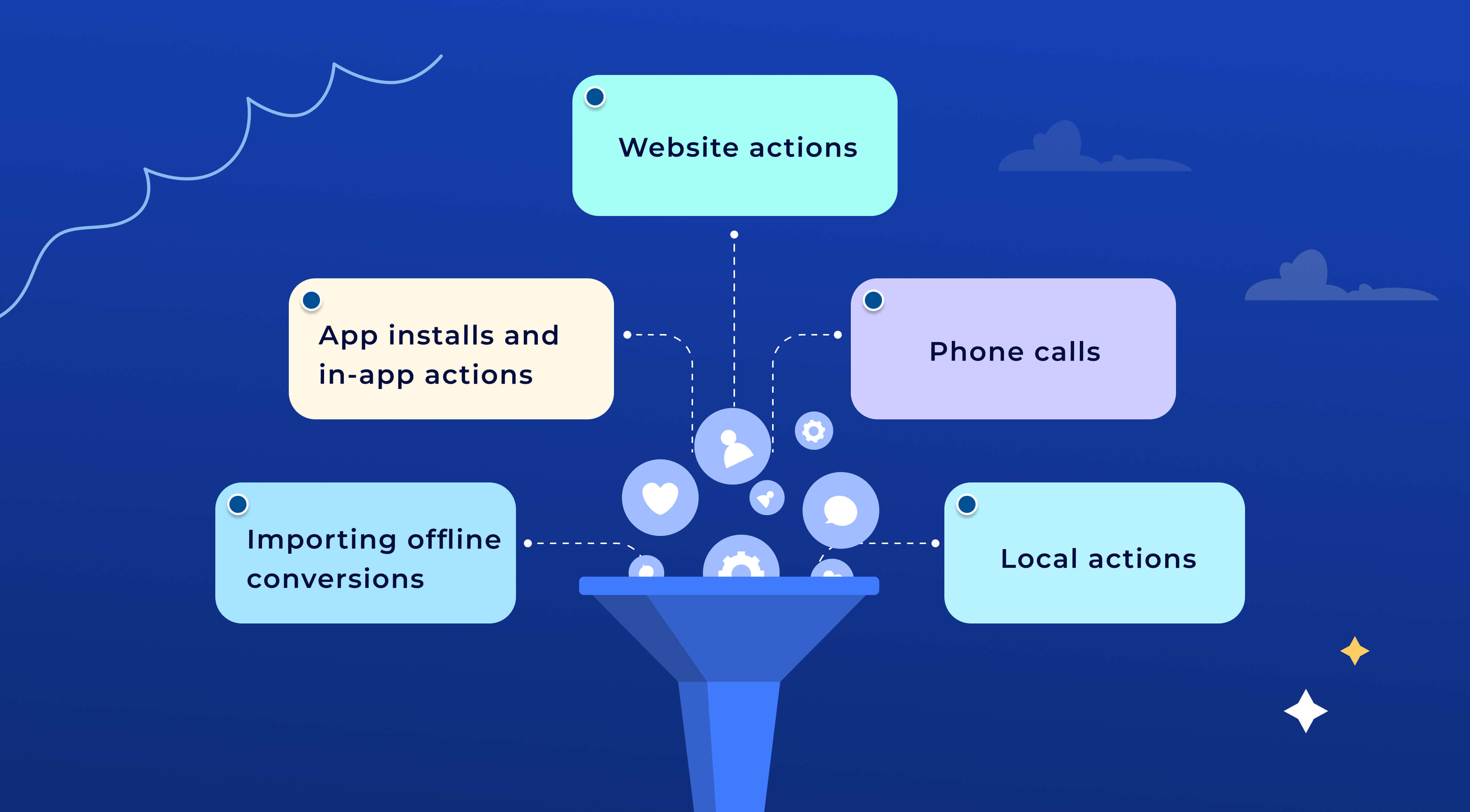What Is a Conversion in Google Ads and Why It Matters

 10 min
10 min
To start with, running Google Ads without tracking conversions is like flying blind in a hurricane without radar. You are spending money, certainly, but are you earning money? The million-dollar query is that one. And the only word that provides the solution is conversions.
In the disorderly realm of digital advertising, impressions and clicks could seem as indicators of success. Actually, though, they are simply noise until they produce anything significant—such as a phone call, a sign-up, or a sale. Here is where conversions find application. They are not only one measure; they are not only another statistic. They are the result—that which your whole campaign aims at.
We are delving further into Google Ads conversions in this newsletter. These are what? Why do these things matter? How do you keep track of them without having your hair fly out? More significantly, how might knowledge of them turn your advertising from a revenue drain into a conversion machine?
Let's start with the fundamentals since even the most astute marketers occasionally need a reminder of what actually counts.
What Is a Conversion in Google Ads?
A conversion in Google Ads is the action you want your user to take. It’s the endgame. The moment a user does what you hoped they would do when they clicked on your ad.
That could be buying a product, booking a consultation, filling out a contact form, downloading an app, or even spending a specific amount of time on your website. It all depends on your business goals.
Think of a conversion as the payoff for all your advertising effort. If someone clicks your ad and leaves your site within five seconds? Not a conversion. If someone clicks your ad and then signs up for your newsletter, books a call, or purchases a product? That’s a win. That’s a conversion.
Here’s the kicker: conversions don’t just measure success—they define it. Without conversions, your campaign has no real direction. You’re just throwing budget into the wind and hoping something sticks.
Why Conversions Are the Heartbeat of Every Paid Campaign
Conversions are not just one part of your strategy—they are the core. They tell you what’s working, what’s not, and where your money is best spent.
Without conversion data, you’re operating on assumptions. But with it? You’re armed with insight. You can optimize campaigns, refine your targeting, tweak your messaging, and allocate budget with surgical precision.
Let’s say you’re running two ads. One gets lots of clicks, the other fewer. At first glance, you might think the high-click ad is the winner. But wait—what if the one with fewer clicks actually results in more purchases? Without conversion tracking, you’d never know. And you’d be scaling the wrong campaign.
Conversions connect the dots between your ad spend and your revenue. They’re not vanity metrics—they’re the business metrics. And once you start thinking in terms of conversions, everything changes: your strategy sharpens, your ROI improves, and your campaigns actually start driving growth instead of just draining budgets.
Want More Conversions from Your Google Ads?
Learn how to turn every click into a real lead or sale with expert optimization strategies.
Get Started!
The Different Types of Conversions You Can Track

Not all conversions are created equal—and Google Ads gives you the flexibility to track exactly what matters to your business. Here are the main types of conversions you can track:
- Website actions: These include purchases, sign-ups, form submissions, or even time spent on a specific page. If it happens on your site, you can probably track it.
- Phone calls: Google can track calls made directly from your ads or from a number on your website (using call forwarding).
- App installs and in-app actions: For mobile-first businesses, tracking app downloads or actions taken within the app—like purchases or level completions—is crucial.
- Local actions: These include store visits or directions clicks, especially relevant for brick-and-mortar businesses.
- Importing offline conversions: If your sales happen over the phone or in person after a lead fills out a form, you can import that data to close the loop.
The magic lies in choosing the conversions that truly reflect your goals. A SaaS company might obsess over form fills, while an e-commerce brand is laser-focused on completed transactions. Define your “win,” and track it ruthlessly.
How to Set Up Conversion Tracking That Works
![]()
Setting up conversion tracking might sound technical—and, okay, it can be—but Google makes it as straightforward as possible, even for non-developers. Here's a high-level view of the process:
- Choose the right conversion action: Go to the “Conversions” section in your Google Ads dashboard and select the type of conversion you want to track—website, app, call, or import.
- Set the parameters: Name your conversion, assign a value (if applicable), choose how to count (every or one), and define a conversion window.
- Install the tag: You’ll be provided with a snippet of code (called a tag) to add to your site. If you're using Google Tag Manager (GTM), it's even simpler. No hardcoding needed—just plug and play.
- Test and verify: Before you launch your campaigns, double-check that your tags are firing correctly. Use tools like Google Tag Assistant or the Google Ads Tag diagnostics feature.
- Let the data roll in: Once set up, conversions will start showing up in your dashboard, and you’ll be able to tie every dollar spent to a real result.
Tracking might feel like a backend chore, but it’s the lifeline of smart marketing. Without it, you’re just guessing. With it, you’re making data-driven decisions that scale.
Struggling to Track Conversions?
Let us help you set up accurate conversion tracking so you know what’s really working.
Request Expert Help Today!
Primary vs. Secondary Conversions: What’s the Real Difference?
Not all conversions carry the same weight. Some signal the end of the customer journey, others are just pit stops along the way. That’s why Google Ads allows you to categorize them as Primary or Secondary conversions.
Primary conversions
They are your main performance indicators—they represent your core business goals. Think purchases, sign-ups, or lead form submissions. These are the conversions you optimize for in your bidding strategy. Google uses this data to drive better results and more of the actions that truly matter to your bottom line.
Secondary conversions
They are supporting actions. They’re valuable, but they don’t define campaign success. These might include video views, page scrolls, or downloading a free resource. You track them for insight, not bidding.
Why does this distinction matter?
- Optimization control – You don’t want Google optimizing for low-value actions like newsletter sign-ups when your goal is actual purchases. Labeling appropriately helps the algorithm focus on the right outcomes.
- Better reporting clarity – Segmenting conversions helps avoid misreading your campaign performance. Ten secondary conversions don’t equal ten sales.
- Smarter budgeting – Knowing which actions are primary prevents you from chasing vanity metrics and wasting budget on low-impact goals.
In short, the primary vs. secondary distinction turns your campaigns from broad guesswork into strategic precision.
Attribution Models Decoded: Which One Should You Choose?
Attribution models decide how credit is assigned to the touchpoints a user interacts with before converting. And this choice isn’t just technical—it directly shapes how you interpret performance and make strategic decisions.
Here are the key attribution models you can choose from:
- Last-click: Gives all credit to the final click before conversion. It’s simple, but often unfair to earlier interactions that played a role in influencing the user.
- First-click: Attributes credit to the first interaction. Great for understanding what brought people into the funnel, but it ignores everything that happens afterward.
- Linear: Distributes credit equally across all touchpoints. It’s balanced, but not nuanced.
- Time decay: Gives more weight to interactions closer to the point of conversion. Useful for long sales cycles where recent actions matter more.
- Position-based: Splits credit between the first and last clicks (typically 40% each), with the rest divided among the middle interactions. Ideal for recognizing both awareness and closing roles.
- Data-driven: Uses machine learning to assign credit based on real user behavior and historical data. It’s the most accurate, but only available once you have enough conversion volume.
Choosing the right model depends on your business type, sales cycle, and what you value most—discovery, nurturing, or closing. For most advertisers today, data-driven attribution is the gold standard because it adapts to real-world behavior instead of relying on assumptions.
Avoid These Conversion Tracking Mistakes
![]()
Even experienced marketers trip over conversion tracking—and the consequences can be costly. Here are the most common missteps and how to dodge them:
A. Not setting up conversion tracking at all
You’d be surprised how many campaigns still fly without it. If you’re not tracking, you’re not optimizing. Set it up before launching any campaign.
B. Tracking the wrong actions as conversions
A user clicking a button isn’t the same as making a purchase. Avoid labeling shallow interactions as your main goals.
C. Using only last-click attribution
This outdated model ignores the full customer journey. Use a model that reflects reality—ideally data-driven attribution.
D. Double-counting conversions
Improper tag implementation can inflate your results. Always test your tags and monitor anomalies in conversion data.
E. Ignoring cross-device behavior
A user might click your ad on mobile but convert later on desktop. Without proper tracking, you’ll miss that connection.
F. Failing to import offline conversions
If your sales happen outside your website—via phone or in person—make sure you’re closing the loop by importing offline data.
G. Not using Google Tag Manager (GTM)
Hardcoding tags is messy and error-prone. GTM streamlines tag management and allows for clean, scalable tracking.
Avoiding these mistakes isn’t just about accuracy—it’s about unlocking the full value of your ad spend. Small tracking errors can skew big decisions.
More Clicks Don’t Always Mean More Sales
Find out how to optimize your Google Ads for real business results—not just traffic.
Get a Free Consultation!
Conclusion
Conversion tracking isn’t optional—it’s the foundation of every successful Google Ads strategy. From understanding what actions matter, to choosing how they’re measured, to avoiding costly setup mistakes, each step plays a role in your campaign’s performance.
The difference between a campaign that bleeds budget and one that delivers consistent ROI often comes down to how well you define, track, and optimize for conversions. It's not just about what you spend—it's about what you get back.
So whether you're running a local business or managing a global brand, take the time to set your conversions straight. Your bottom line will thank you.
And if you're looking to scale your campaigns without burning through your budget, our affordable PPC services are designed to help you do just that—with performance that speaks for itself.
FAQs
A conversion in Google Ads refers to the action a user takes after clicking on your ad, such as making a purchase, signing up, or filling out a form. It measures how well your ads drive valuable actions. Tracking conversions helps you understand if your ads are delivering the results you want.
Conversion tracking is crucial because it allows you to measure the success of your campaigns. Without it, you can’t determine what’s working or what isn’t. By tracking conversions, you can optimize your ads to increase ROI and ensure you're spending your budget wisely.
To set up conversion tracking, create a conversion action in Google Ads, then add a tracking tag to your website. You can also use Google Tag Manager for easier management of tags. Once set up, Google Ads will start recording data on the conversions that matter most to your business.
Primary conversions are the key actions that directly align with your business goals, like a sale or lead generation. Secondary conversions, though still valuable, are supporting actions like a user watching a video or signing up for a newsletter. Both offer insights, but primary conversions are your main focus.
Attribution models help you assign credit to various touchpoints in a customer’s journey. Choosing the right model—like first-click, last-click, or data-driven—can drastically affect how you interpret your ad performance and make decisions to improve future campaigns.
Common mistakes include not setting up conversion tracking at all, double-counting conversions, or choosing the wrong attribution model. To avoid these errors, ensure proper tag implementation, regularly test your setup, and choose an attribution model that aligns with your business goals.




